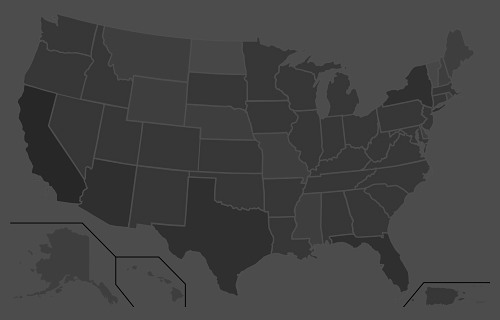“Our added winter moisture and active calling period led to a very long nesting and hatching season, starting in late April and extending into early summer, with chicks hatching as late as early July,” O’Dell said. “From a population standpoint, we are out of a deficit for the first time since 2001-2002. Quail are starting to pop up in places they haven’t been seen in a while.
“If you’ve never had the chance to experience what Arizona quail hunting built its name on, then this would be the year to get out and enjoy it.”
Meanwhile, hunters should note that the season for Mearns’ quail doesn’t begin until Dec. 4. It’s summer rainfall that plays a key role in nesting success and population numbers of this species. After a spotty and relatively weak monsoon across southern Arizona, these birds are likely to be abundant only in pockets that received sufficient precipitation this summer.
A valid Arizona hunting or combination hunt and fish license is required for all hunters 10 and older. Those hunters under 10 must either have a valid hunting or combination hunt and fish license, or be accompanied by an adult who possesses a valid hunting or combination hunt and fish license. Licenses can be purchased online or at license dealers statewide. A youth combination hunt and fish license (ages 10 to 17) is $5.
The general bag limit is 15 quail per day in the aggregate, of which no more than eight may be Mearns’ quail (when the Mearns’ season opens Dec. 4). The general possession limit is 45 quail in the aggregate after opening day, of which no more than 15 Gambel’s, scaled or California quail in the aggregate may be taken in any one day. After the opening of the Mearns’ season, the 45-quail possession limit may include 24 Mearns’ quail, of which no more than eight may be taken in any one day.
More quail-hunting information can be found on the department’s website at https://www.azgfd.com/Hunting/. Another resource for both new and experienced hunters alike is “An Introduction to Hunting Arizona’s Small Game.” Written by Randall D. Babb, the 196-page, full-color book covers where and how to hunt small game birds (like quail), squirrels, rabbits, ducks and geese. It also includes how to prepare and cook your harvest, with illustrations and recipes. The book can be ordered for $16.95 at www.azgfd.gov/publications.
Finally, hunters should check out O’Dell’s techniques for field-dressing quail at https://www.youtube.com/watch?v=3gRwZAcWzzk.
####
Publishers Notes: OUT OF STATE HUNTERS, FISHERMEN & OUTDOOR ENTHUSIASTS; Due to the Covid 19 pandemic, there could be limitations for OUT of STATE hunters, fishermen and other outdoor enthusiasts to include a 14-day quarantine requirement or negative COVID-19 testing alternative. Please check with the State's Department of Natural Resources BEFORE you travel or apply for the 2020 Fall Hunts.
Disclaimer: The views expressed on this site are that of the authors and not necessarily that of TBC Press
Texas Abandoned Crab Trap Removal Dates Set for 2021
Submitted by: TBC Press
Posted on: 02/03/21
The Backcountry Press
The country's premier daily HUNTING, FISHING & OUTDOOR news in the USA and around the globe. Read whats happening in your neck of the woods & beyond.
© 2020 TBC Press - All Rights Reserved Website Design by:
News # 14195
These sites are denoted as “facilitated” in the list below. Registration with partner organizations may be required. Additionally, at all sites, dumpsters or collection areas marked with banners will be available to receive traps for the duration of the closure. Volunteers may focus their efforts on Feb. 20 or work at their own pace anytime during the closure, but traps cannot be removed prior to Feb. 19 or after Feb. 28.
The Coastal Conservation Association Texas, Coastal Bend Bays & Estuaries Program, Galveston Bay Foundation, San Antonio Bay Partnership, and the U.S. Fish and Wildlife Service are providing continued support to the crab trap removal program. Numerous other organizations and companies also are volunteering their services.
To participate, volunteers may pick up free tarps, gloves, face coverings, and additional information at their local TPWD Coastal Fisheries field stations. TPWD requests that volunteers who remove traps record and submit information about the number of traps they collect as well as documenting any sightings of diamondback terrapins.
All other legal means of crabbing will not be affected during the closure period for wire crab traps. For more information, contact your local TPWD Coastal Fisheries office or Holly Grand at (361) 825-3993 or [email protected].
Learn more about the Texas Abandoned Crab Trap Removal Program’s history on our website or watch a YouTube video produced by TPWD.
View the list of 2021 Crab Trap Drop-Off Sites
####
Publishers Notes: Our country is still battling COVID-19. To avoid the spread of this virus and continue to enjoy outdoor activities, ALL outdoor enthusiasts (man, woman, child) should follow the guidelines set by nps.gov. These guidelines include; social distancing, the Leave No Trace principles, including pack-in and pack-out, to keep outdoor spaces safe and healthy.
Each February for 19 years, countless volunteers spend 10 days on the water along the Texas coastline searching the bays for abandoned crab traps left to foul shrimpers’ nets, snag anglers’ lines, “ghost fish,” and create unsightly views. To date, they’ve hauled off more than 38,000 of these derelict traps.
From February 19th through the 28th, Texas coastal waters will be closed to crabbing with wire mesh crab traps to facilitate the annual volunteer crab trap cleanup. Any traps left in bays — including traps tied to docks — will be assumed abandoned and considered “litter” under state law. This allows volunteers to legally remove any crab traps they find.
Volunteers are needed to assist in the coast-wide effort to remove the numerous traps that have been lost or abandoned since last year’s cleanup. Volunteers are urged to wear masks and keep socially distance from those not in your household when appropriate. In an effort to facilitate volunteer efforts, several sites along the coast will have clean-up events on February 20 from 8am until noon.












